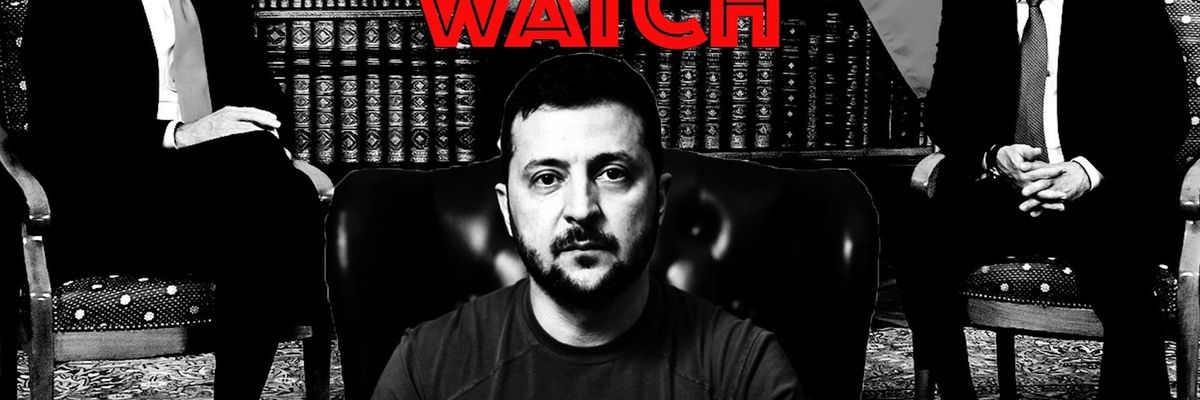Ukrainian President Volodymyr Zelensky in a video conference on Monday urged the leaders of the G7 countries — Canada, France, Germany, Italy, Japan, the United Kingdom, and the United States — to back his proposal for a “special summit” aimed at implementing his 10-point plan for peace.
"I suggest that you, like other conscientious states, show your leadership — in the implementation of the peace formula as a whole or its specific points," Zelensky said.
While the G7 leaders made no specific commitments on Zelensky’s proposal, his idea that it be based on his 10-point plan is notable considering that one of its specific points reiterates Zelensky’s stance that the war will end only when Russia withdraws its forces from all of Ukraine, perhaps including Crimea, a region the plan refers to as “temporarily occupied.”
While Ukraine’s backers in the West often defer to Zelensky and Ukrainian officials on what the war’s ultimate outcomes might be, it appears that some slight cracks are beginning to emerge.
For example, former British Prime Minister Boris Johnson has been one of Zelensky’s biggest supporters (and vice versa), but on Friday it appears that Johnson quietly amended his Zelensky-aligned vision for the Ukraine war’s end game.
In a Wall Street Journal op-ed calling for more military and economic support for Ukraine, Johnson said the only way the war can end is “with Vladimir Putin’s defeat.” That means, he wrote, that “Russian forces must be pushed back to the de facto boundary of Feb. 24. There is no way Volodymyr Zelensky or the Ukrainian people could conceivably accept another outcome… .”
Before the February 24, 2022 Russian invasion, Ukraine’s “de facto boundary” not only did not include Crimea, but it also did not include parts of the Donbas region in the east on Ukraine’s border with Russia.
But this is a clear shift in Johnson’s thinking. Just last month, also in a Journal op-ed, the former prime minister — who reportedly worked to scuttle a deal back in April similar to the one he proposed on Friday — called the idea of Putin keeping parts of the Donbas “repugnant.”
The Guardian’s Patrick Wintour wrote this week that Johnson’s op-ed last Friday was “little noticed” and “startling,” noting that Henry Kissinger “made a similar proposal, arguing Russia should only be required to disgorge territory gained since February this year. Land occupied nearly a decade ago, including Crimea, ‘could be the subject of a negotiation after a ceasefire.’”
Wintour adds that “Johnson was making an admission made in private by many diplomats that a militarily enforced return of the Crimean peninsula — which was annexed by Russia in 2014 in a move rejected by the UN — to full Ukrainian control is fraught with risk.”
Meanwhile, a new poll this week conducted by the Chicago Council on Global Affairs and the Moscow-based Levada Center found that 53 percent of Russians favor starting negotiations with Ukraine to end the war. That number jumps to 62 percent when respondents were provided with costs Russia has endured.
Regarding specific outcomes of any future talks, the survey found that 78 percent of Russians said that returning Crimea to Ukraine would be unacceptable and 66 percent said the same for the eastern Donbas region.
The Washington Post called the Levada Center “one of Russia’s most widely respected independent polling companies” and that “the survey’s authors said earlier this year they found no evidence that respondents were unwilling to share their true feelings with interviewers."
***
In other diplomatic news related to the war in Ukraine:
Turkey’s President Tayyip Erdogan spoke with both Zelensky and Putin this week regarding the Black Sea grain export agreement, Reuters reported. Russia is reportedly seeking better guarantees on its exports while Ukraine wants more ports open for shipping.
French President Emmanuel Macron hosted a conference in Paris this week, according to the Associated Press, where allied countries and other international organizations pledged to provide Ukraine with more than $1 billion in aid to help the war torn country endure a long winter amid constant Russian attacks on civilian infrastructure.
Suedi Murekezi, a U.S. Air Force veteran who was captured by Russian forces in June, was released as part of a larger prisoner swap between Ukraine and Russia, according to the Washington Post. Murekezi had been living in Ukraine since 2018 and was arrested for allegedly taking part in pro-Ukraine protests.
U.S. State Department news:
State Department spokesman Ned Price on Tuesday criticized the Russians for rejecting Zelensky’s call to withdraw its troops from Ukraine by Christmas. “That vision of a just peace wasn’t met with a reciprocal vision for a just peace on the part of the Russian Federation,” Price said. “Instead, it was met with bombs and missiles raining down on Ukrainian towns and cities, a continuation of the brutal escalation and assault that Russia’s forces have undertaken against civilian targets… .” Price added that the Russian response is “a very clear acknowledgement that Russia is in no mood for constructive dialogue… .”














